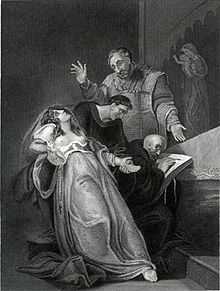Elizabeth Barton

Sister Elizabeth Barton (1506? – 20 April 1534), known as "The Nun of Kent", "The Holy Maid of London", "The Holy Maid of Kent" and later "The Mad Maid of Kent", was an English Catholic nun. She was executed as a result of her prophecies against the marriage of King Henry VIII of England to Anne Boleyn.[1]
Life
Little is known of Elizabeth Barton's early life. She was born in 1506 in the parish of Aldington, about twelve miles from Canterbury, [2] and appears to have come from a poor background. She was working as a servant when her visions began in 1525. At the age of 18, while working as a domestic servant in the household of Thomas Cobb, a farmer of Aldington, she suffered from a severe illness and claimed to have received divine revelations. These predicted future events, such as the death of a child living in her household, or more frequently took the form of pleas for people to remain in the Roman Catholic Church. She also urged people to pray to the Blessed Virgin Mary and to undertake pilgrimages. Thousands believed in her prophecies and Archbishop William Warham and Bishop John Fisher attested to her pious life.[3]
When certain events she foretold apparently came to pass, her reputation spread. The parish priest Richard Masters referred the matter to Archbishop Warham, who appointed a commission to ensure that none of her prophesies was at variance with Catholic teaching. When the commission decided favorably, Warham arranged for Barton to be received in the Benedictine priory of St. Sepulchre at Canterbury.[2]
In 1528 she held a private meeting with Cardinal Thomas Wolsey, the second most powerful man in England next to King Henry, and soon thereafter met twice with the king himself. King Henry accepted Barton because her prophecies did not at that time challenge the existing order. Her prophecies warned against heresy and condemned rebellion at a time when the King was attempting to stamp out Lutheranism and was afraid of possible uprising or even assassination by his enemies.
However, when the King began the process of obtaining an annulment of his marriage to Catherine of Aragon and seizing control of the Church in England from Rome, he turned against her. Barton strongly opposed the English Reformation and, around 1532, began prophesying that if Henry remarried, he would die shortly thereafter, and said she had seen the place in Hell where he would go (in fact, Henry lived for another 15 years). Remarkably, Barton went unpunished for nearly a year, largely, it appears, because she was more popular than the King among rich and poor alike. Since she had not committed any treasonous actions, the King was compelled to pass an attainder, an Act of Parliament authorizing punishment without trial. The King's agents spread rumours that she was engaged in sexual relationships with priests and that she suffered from mental illness. Many prophecies, as Thomas More thought, were fictitiously attributed to her.[2]
Her reputation thus undermined, the Crown arrested Barton in 1533 and forced her to confess that she had fabricated her revelations.[1] However, all that is known regarding her confession comes from Thomas Cromwell, his agents, and other sources on the side of the Crown. Friar John Laurence of the Observant Friars of Greenwich gave evidence against the Maid and fellow Observants, Friars Hugh Rich and Richard Risby, and then requested to be named to one of the posts left vacant due to their imprisonment.[4] She, along with five of her chief supporters, four of whom were priests, were executed for treason and hanged at Tyburn.[1] She was buried at Greyfriars Church in Newgate Street, but her head was put on a spike on London Bridge, the only woman in history accorded that dishonour.
Legacy
Churches such as the Church of St. Augustine of Canterbury[5] and the Nephite Church of Christ[6] continue to venerate Sister Barton.
The case of Elizabeth Barton is dealt with extensively in the 2009 historical novel Wolf Hall by Hilary Mantel.
See also
| Wikisource has the text of the 1911 Encyclopædia Britannica article Barton, Elizabeth. |
References
- ↑ 1.0 1.1 1.2 "Elizabeth Barton" The Catholic Encyclopedia. Vol. 2. New York: Robert Appleton Company, 1907. 18 Feb. 2013
- ↑ 2.0 2.1 2.2 Hamilton O. S. B., Adam. The Angel of Syon, The Life and Martyrdom of Blessed Richard Reynolds, Sands & Co., London, 1905
- ↑ A Popular History of the Reformation, p.177, Philip Hughes, 1957
- ↑ Camm O.S.B.,Dom Bede. "Blessed John Forest". Lives of the English Martyrs Declared Blessed by Pope Leo XIII, Vol. I, p.280, Longmans, Green and Co., London 1914
- ↑ Church of St Augustine of Canterbury, Anglican Catholic, 2009–10, retrieved 22 June 2010 .
- ↑ Wray, Kristopher S (2010), The Nephite Order: The Code of Doctrine & Discipline of the Nephite Church of Christ, Orem, Utah: The Association for Mormon Letters, retrieved 1 July 2010
Bibliography
- McKee, John (1925), Dame Elizabeth Barton OSB, the Holy Maid of Kent, London: Burns, Oates and Washbourne.
- Neame, Alan (1971), The Holy Maid of Kent: The Life of Elizabeth Barton: 1506–1534, London: Hodder and Stoughton, ISBN 0-340-02574-3.
- Shagan, Ethan H (2003), "Chapter 2: The Anatomy of opposition in early Reformation England; the case of Elizabeth Barton, the holy maid of Kent", Popular Politics in the English Reformation, Cambridge, UK: Cambridge University Press, pp. 61–88.
- Watt, Diane (1997), Secretaries of God, Cambridge, UK: DS Brewer.
External links
- Watt, Diane, "Barton, Elizabeth (c. 1506–1534)", Dictionary of National Biography, Oxford, doi:10.1093/ref:odnb/1598.
|